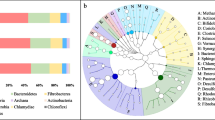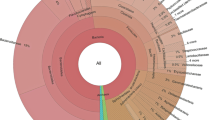Abstract
Cellulose is the most abundant natural polymer present on Earth in the form of agriculture waste. Hydrolysis of agriculture waste for simple fermentable reducing sugars is the bottleneck in the area of biofuel generation and other value-added products. The present study aims to utilize the camel rumen as a bioreactor for potent cellulolytic and hemicellulolytic bacteria by altering the feed types with varying cellulosic concentrations. A total of 6716 bacterial cultures were subjected to three layers of screening, where plate zymography and chromophoric substrate screening served as primary screening method for cellulolytic and hemicellulolytic potential. The potential isolates were genetically grouped using RAPD, and 51 representative isolates from each group were subjected to molecular identification through 16S rDNA sequencing, followed by quantification of various cellulolytic and hemicellulolytic enzymes. Out of 51 potent isolates, 5 isolates had high endoglucanase activity ranging from 0.3 to 0.48 U/ml. The selected five key isolates identified as Pseudomonas, Paenibacillus, Citrobacter, Bacillus subtilis, and Enterobacter were employed for hydrolyzing the various agriculture residues and resulted in approximately 0.4 mg/ml of reducing sugar. Furthermore, the metaculturomics approach was implemented to deduce the total cultured diversity through 16S rRNA amplicon library sequencing. The metaculturomics data revealed the dominance of proteobacteria and unidentified bacterial population in all four feed types, which indicates the possibility of culturing novel cellulose-deconstructing bacteria. Moreover, the presence of diverse hydrolytic enzymes in cultured isolates supports the usage of these bacteria in bio-processing of agriculture waste residues and obtaining the biofuels and other value-added products.








Similar content being viewed by others
References
Bohra V, Dafale NA, Purohit HJ (2018) Paenibacillus polymyxa ND25: candidate genome for lignocellulosic biomass utilization. 3 Biotech 8:1–7. https://doi.org/10.1007/s13205-018-1274-3
Bohra V, Tikariha H, Dafale NA (2019) Genomically defined paenibacillus polymyxa ND24 for efficient cellulase production utilizing sugarcane bagasse as a substrate. Appl Biochem Biotechnol 187:266–281. https://doi.org/10.1007/s12010-018-2820-5
Carlos C, Fan H, Currie CR (2018) Substrate shift reveals roles for members of bacterial consortia in degradation of plant cell wall polymers. Front Microbiol 9:364. https://doi.org/10.3389/fmicb.2018.00364
Chen H, Liu J, Chang X et al (2017) A review on the pretreatment of lignocellulose for high-value chemicals. Fuel Process Technol 160:196–206
Creevey CJ, Kelly WJ, Henderson G, Leahy SC (2014) Determining the culturability of the rumen bacterial microbiome. Microb Biotechnol 7:467–479. https://doi.org/10.1111/1751-7915.12141
de Aguiar SC, Zeoula LM, do Prado OPP et al (2014) Characterization of rumen bacterial strains isolated from enrichments of rumen content in the presence of propolis. World J Microbiol Biotechnol 30:2917–2926. https://doi.org/10.1007/s11274-014-1719-8
de Moraes Akamine DT, de Almeida Cozendey da Silva D, de Lima Câmara G et al (2018) Endoglucanase activity in Neoteredo reynei (Bivalvia, Teredinidae) digestive organs and its content. World J Microbiol Biotechnol 34:1–9. https://doi.org/10.1007/s11274-018-2468-x
Dini IR, Wawan W, Hapsoh H, Sriwahyuni S (2018) Isolation and identification of cellulolytic and lignolytic bacteria from the gut Oryctes rhinoceros L. Larvae decomposition of oil palm empty fruit bunches. Indones J Agric Res 1:193–203. https://doi.org/10.32734/injar.v1i2.314
Du J, Liang J, Gao X et al (2020) Optimization of an artificial cellulase cocktail for high-solids enzymatic hydrolysis of cellulosic materials with different pretreatment methods. Bioresour Technol 295:122272. https://doi.org/10.1016/j.biortech.2019.122272
Gharechahi J, Zahiri HS, Noghabi KA, Salekdeh GH (2015) In-depth diversity analysis of the bacterial community resident in the camel rumen. Syst Appl Microbiol 38:67–76. https://doi.org/10.1016/j.syapm.2014.09.004
Huschner F, Grousseau E, Brigham CJ et al (2015) Development of a feeding strategy for high cell and PHA density fed-batch fermentation of Ralstonia eutropha H16 from organic acids and their salts. Process Biochem 50:165–172. https://doi.org/10.1016/j.procbio.2014.12.004
Jha V, Tikariha H, Dafale NA, Purohit HJ (2018) Exploring the rearrangement of sensory intelligence in proteobacteria: insight of Pho regulon. World J Microbiol Biotechnol 34:1–14. https://doi.org/10.1007/s11274-018-2551-3
Jung H, Yoon HG, Park W et al (2008) Effect of sodium hydroxide treatment of bacterial cellulose on cellulase activity. Cellulose 15:465–471. https://doi.org/10.1007/s10570-007-9190-4
Kalawong R, Wakayama M, Anuntalabhochai S, Wongsawad C, Sangwijit K (2018) Comparison and characterization of purified cellulase and xylanase from Bacillus amyloliquefaciens CX1 and Bacillus subtilis B4. Chiang Mai J Sci 45:92–105
Katiyar P, Srivastava SK, Tyagi VK (2018) Measurement of cellulolytic potential of cellulase producing bacteria. Annu Res Rev Biol 27:1–9. https://doi.org/10.9734/ARRB/2018/34410
Kucera D, Pernicová I, Kovalcik A et al (2018) Characterization of the promising poly(3-hydroxybutyrate) producing halophilic bacterium Halomonas halophila. Bioresour Technol 256:552–556. https://doi.org/10.1016/j.biortech.2018.02.062
Li H, Wu S, Wirth S et al (2016) Diversity and activity of cellulolytic bacteria, isolated from the gut contents of grass carp ( Ctenopharyngodon idellus ) (Valenciennes) fed on Sudan grass ( Sorghum sudanense ) or artificial feedstuffs. Aquac Res 47:153–164. https://doi.org/10.1111/are.12478
Liotti RG, da Silva RC, Pinheiro DG et al (2019) Characterization and comprehensive analysis of the ecological interaction networks of bacterial communities in Paullinia cupana var. sorbilis by 16S rRNA gene metabarcoding. World J Microbiol Biotechnol 35:1–15. https://doi.org/10.1007/s11274-019-2758-y
Madhaiyan M, Poonguzhali S, Saravanan VS et al (2017) Paenibacillus polysaccharolyticus sp. Nov., a xylanolytic and cellulolytic bacteria isolated from leaves of bamboo Phyllostachys aureosulcata. Int J Syst Evol Microbiol 67:2127–2133. https://doi.org/10.1099/ijsem.0.001901
Martim DB, Barbosa-Tessmann IP (2019) Two novel acetylesterases from pantoea dispersa: recombinant expression, purification, and characterization. Appl Biochem Biotechnol 189:834–854. https://doi.org/10.1007/s12010-019-03024-y
Mihajlovski K, Buntić A, Milić M et al (2020) From Agricultural waste to biofuel: enzymatic potential of a bacterial isolate Streptomyces fulvissimus CKS7 for bioethanol production. Waste and Biomass Valorization. https://doi.org/10.1007/s12649-020-00960-3
Mishra P, Nilam Tulsani J et al (2020) Exploring the eukaryotic diversity in rumen of Indian camel (Camelus dromedarius) using 18S rRNA amplicon sequencing. Arch Microbiol 1:3. https://doi.org/10.1007/s00203-020-01897-w
Niu Y, Wu L, Shen Y et al (2019) Coexpression of β-xylosidase and xylose isomerase in Saccharomyces cerevisiae improves the efficiency of saccharification and fermentation from xylo-oligosaccharides. Cellulose 26:7923–7937. https://doi.org/10.1007/s10570-019-02650-3
Nyonyo T, Shinkai T, Mitsumori M (2014) Improved culturability of cellulolytic rumen bacteria and phylogenetic diversity of culturable cellulolytic and xylanolytic bacteria newly isolated from the bovine rumen. FEMS Microbiol Ecol 88:528–537. https://doi.org/10.1111/1574-6941.12318
Ouyang W, Yepez A, Romero AA, Luque R (2018) Towards industrial furfural conversion: selectivity and stability of palladium and platinum catalysts under continuous flow regime. Catal Today 308:32–37. https://doi.org/10.1016/j.cattod.2017.07.011
Prasad SK, Samota A, Singh MK, Verma SK (2014) Cultivars and nitrogen levels influence on yield attributes, yield and protein content of pearl millet under semi-arid condition of vindhyan region. The Ecoscan 6:47–50
Prado LA, Ferlay A, Nozière P, Schmidely P (2019) Predicting duodenal flows and absorption of fatty acids from dietary characteristics in ovine and bovine species: a meta-analysis approach. Animal 13:727–739. https://doi.org/10.1017/S1751731118001982
Rutherford NH, Lively FO, Arnott G (2019) Evaluation of rumen temperature as a novel indicator of meat quality: rumen temperature, and haematological indicators of stress during the pre-slaughter period as predictors of instrumental meat quality in bulls. Meat Sci 158:107913. https://doi.org/10.1016/j.meatsci.2019.107913
Samsudin AA, Wright ADG, Al JR (2012) Cellulolytic bacteria in the foregut of the dromedary camel (Camelus dromedarius). Appl Environ Microbiol 78:8836–8839. https://doi.org/10.1128/AEM.02420-12
Sharma D, Sud A, Bansal S et al (2018) Endocellulase production by Cotylidia pannosa and its application in saccharification of wheat bran to bioethanol. Bioenergy Res 11:219–227. https://doi.org/10.1007/s12155-017-9890-z
Shi X, Liu Q, Ma J et al (2015) An acid-stable bacterial laccase identified from the endophyte Pantoea ananatis Sd-1 genome exhibiting lignin degradation and dye decolorization abilities. Biotechnol Lett 37:2279–2288. https://doi.org/10.1007/s10529-015-1914-1
Waghmare PR, Khandare RV, Jeon B-H, Govindwar SP (2018) Enzymatic hydrolysis of biologically pretreated sorghum husk for bioethanol production. Biofuel Res J 19:846–853. https://doi.org/10.18331/BRJ2018.5.3.4
Wilson DB (2009) Evidence for a novel mechanism of microbial cellulose degradation. Cellulose 16:723–727. https://doi.org/10.1007/s10570-009-9326-9
Acknowledgements
The funding from DBT project Ref. No: BT/PR15586/AAQ/1/651/2015 is gratefully acknowledged for carrying out this research work. The manuscript has been checked for plagiarism by Knowledge Resource Centre, CSIR-NEERI, Nagpur, India, and assigned KRC No.: CSIR-NEERI/KRC/2020/APRIL/EBGD/1.
Author information
Authors and Affiliations
Contributions
HJP, CGJ and NAD conceptualized the study, NVP performed the feeding experiment, SJJ performed sample collection and sequencing, SS performed screening experiments, enzyme activity, DNA isolation, bioinformatics analysis and draft manuscript writing, HJP and NAD planned the bioinformatics analysis and improved the manuscript.
Corresponding author
Ethics declarations
Conflict of interest
The authors declare no financial or commercial conflict of interest.
Ethical approval
The experiment was performed under the approval of the institutional animal ethics committee of the National Research Center on Camel, Bikaner, Rajasthan.
Additional information
Communicated by Erko Stackebrandt.
Publisher's Note
Springer Nature remains neutral with regard to jurisdictional claims in published maps and institutional affiliations.
Electronic supplementary material
Below is the link to the electronic supplementary material.
Rights and permissions
About this article
Cite this article
Srivastava, S., Dafale, N.A., Jakhesara, S.J. et al. Unraveling the camel rumen microbiome through metaculturomics approach for agriculture waste hydrolytic potential. Arch Microbiol 203, 107–123 (2021). https://doi.org/10.1007/s00203-020-02010-x
Received:
Revised:
Accepted:
Published:
Issue Date:
DOI: https://doi.org/10.1007/s00203-020-02010-x




